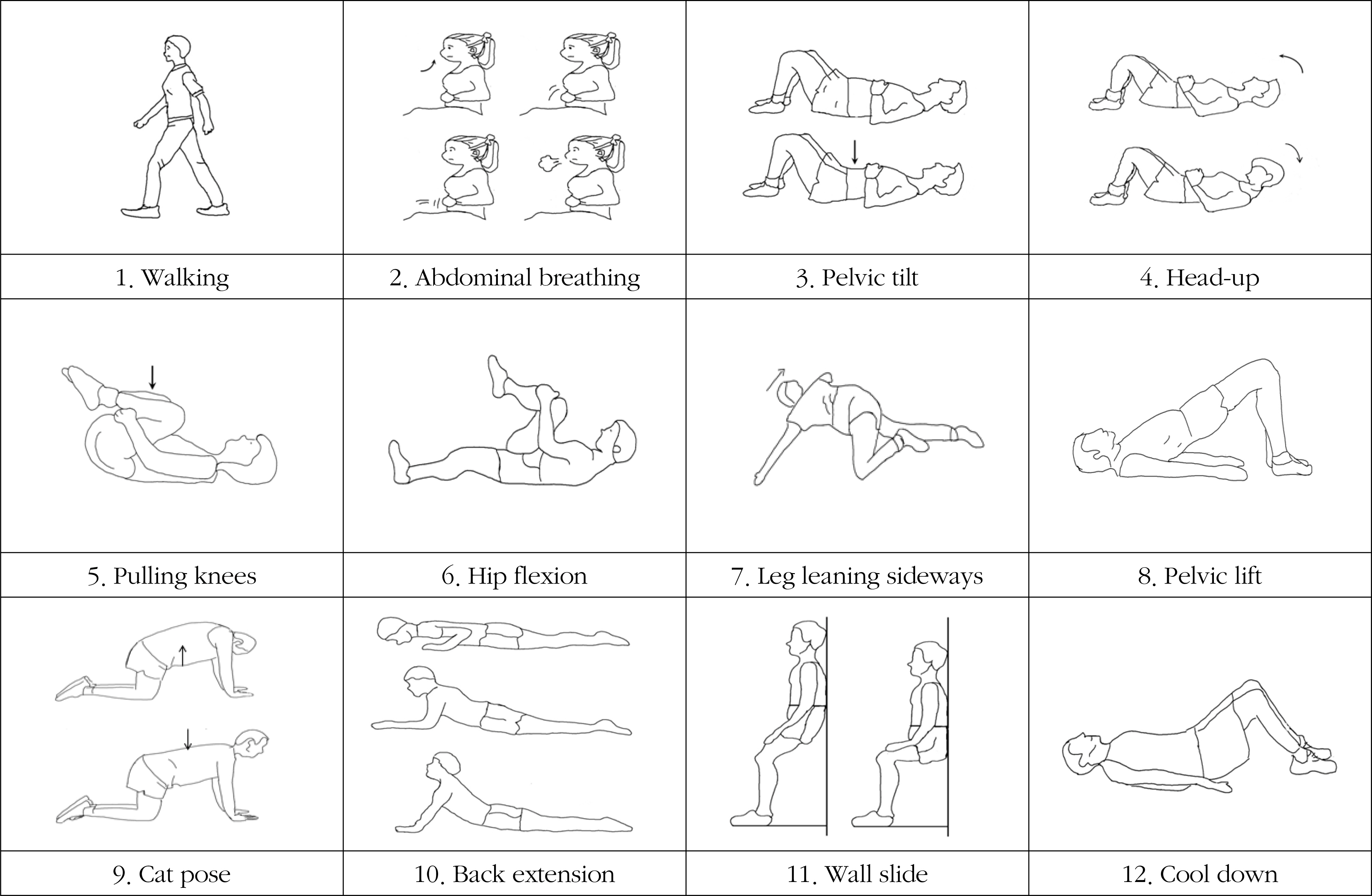1Lee Chun Tek Hospital, Suwon
2College of Nursing, Chonbuk National University, Jeonju, Korea
© 2013 Korean Society of Adult Nursing
This is an Open Access article distributed under the terms of the Creative Commons Attribution Non-Commercial License (http://creativecommons.org/licenses/by-nc/3.0/) which permits unrestricted non-commercial use, distribution, and reproduction in any medium, provided the original work is properly cited.
| Characteristics | Categories | Exp. (n=25) | Cont. (n=27) | x2 or t | p |
|---|---|---|---|---|---|
| n (%) or M±SD | n (%) or M±SD | ||||
| Gender | Male | 11 (44.0) | 15 (55.6) | 0.69 | .405 |
| Female | 14 (56.0) | 12 (44.4) | |||
| Age (year) | 42.60±10.95 | 48.11±9.40 | -1.95 | .057 | |
| Education | ≤Middle school | 8 (32.0) | 14 (51.9) | 2.09 | .171 |
| ≥High school | 17 (68.0) | 13 (48.1) | |||
| Spouse | Yes | 8 (32.0) | 7 (25.9) | 0.23 | .629 |
| No | 17 (68.0) | 20 (74.1) | |||
| Occupation | Yes | 18 (72.0) | 17 (63.0) | 0.48 | .488 |
| No | 7 (28.0) | 10 (37.0) | |||
| Standing at work (hour) | 5.12±3.63 | 5.14±3.91 | -0.02 | .979 | |
| Sitting at work (hour) | 4.72±3.15 | 4.22±2.93 | 0.58 | .559 | |
| Hypertension | Yes | 5 (20.0) | 6 (22.2) | 0.03 | .845 |
| No | 20 (22.2) | 21 (77.8) | |||
| Diabetes mellitus | Yes | 2 (8.0) | 4 (14.8) | 0.59 | .442† |
| No | 23 (92.0) | 23 (85.2) | |||
| Arthritis | Yes | 3 (12.0) | 4 (14.8) | 0.08 | 1.000† |
| No | 22 (88.0) | 23 (85.2) |
| Variables | Exp. (n=25) | Cont. (n=27) | t or Z | p |
|---|---|---|---|---|
| M±SD | M±SD | |||
| Pain on extension | 6.72±1.84 | 6.06±1.94 | 1.26 | .106 |
| Pain on flexion | 6.74±1.66 | 6.14±1.93 | 1.20 | .117 |
| Daily living disability | 30.84±4.36 | 30.37±4.27 | 0.39 | .347 |
| Depression | 25.96±8.42 | 25.40±6.53 | -0.30 | .381† |


Homogeneity of General Characteristics (N=52)
| Characteristics | Categories | Exp. (n=25) | Cont. (n=27) | x2 or t | p |
|---|---|---|---|---|---|
| n (%) or M±SD | n (%) or M±SD | ||||
| Gender | Male | 11 (44.0) | 15 (55.6) | 0.69 | .405 |
| Female | 14 (56.0) | 12 (44.4) | |||
| Age (year) | 42.60±10.95 | 48.11±9.40 | -1.95 | .057 | |
| Education | ≤Middle school | 8 (32.0) | 14 (51.9) | 2.09 | .171 |
| ≥High school | 17 (68.0) | 13 (48.1) | |||
| Spouse | Yes | 8 (32.0) | 7 (25.9) | 0.23 | .629 |
| No | 17 (68.0) | 20 (74.1) | |||
| Occupation | Yes | 18 (72.0) | 17 (63.0) | 0.48 | .488 |
| No | 7 (28.0) | 10 (37.0) | |||
| Standing at work (hour) | 5.12±3.63 | 5.14±3.91 | -0.02 | .979 | |
| Sitting at work (hour) | 4.72±3.15 | 4.22±2.93 | 0.58 | .559 | |
| Hypertension | Yes | 5 (20.0) | 6 (22.2) | 0.03 | .845 |
| No | 20 (22.2) | 21 (77.8) | |||
| Diabetes mellitus | Yes | 2 (8.0) | 4 (14.8) | 0.59 | .442 |
| No | 23 (92.0) | 23 (85.2) | |||
| Arthritis | Yes | 3 (12.0) | 4 (14.8) | 0.08 | 1.000 |
| No | 22 (88.0) | 23 (85.2) |
Exp.=experimental group; Cont.=control group.
†Fisher's exact test.
Homogeneity of Dependent Variables (N=52)
| Variables | Exp. (n=25) | Cont. (n=27) | t or Z | p |
|---|---|---|---|---|
| M±SD | M±SD | |||
| Pain on extension | 6.72±1.84 | 6.06±1.94 | 1.26 | .106 |
| Pain on flexion | 6.74±1.66 | 6.14±1.93 | 1.20 | .117 |
| Daily living disability | 30.84±4.36 | 30.37±4.27 | 0.39 | .347 |
| Depression | 25.96±8.42 | 25.40±6.53 | -0.30 | .381 |
Exp.=experimental group; Cont.=control group.
†Mann-Witney U test.
Comparison of Pain, Daily Life Disability, and Depression between Two Groups (N=52)
| Variables | Group | Pre | Post | Difference | t | p |
|---|---|---|---|---|---|---|
| M±SD | M±SD | M±SD | ||||
| Pain on extension | Exp. (n=25) | 6.72±1.84 | 1.86±1.04 | -4.86±1.77 | -2.32 | .012 |
| Cont. (n=27) | 6.06±1.94 | 2.37±.944 | -3.69±1.85 | |||
| Pain on flexion | Exp. (n=25) | 6.74±1.66 | 1.74±1.10 | -5.00±1.88 | -2.37 | .010 |
| Cont. (n=27) | 6.14±1.93 | 2.43±.937 | -3.70±2.04 | |||
| Daily life disability | Exp. (n=25) | 30.84±4.36 | 13.95±4.51 | -16.88±6.01 | -2.41 | 010 |
| Cont. (n=27) | 30.37±4.27 | 17.61±5.07 | -12.75±6.30 | |||
| Depression | Exp. (n=25) | 25.96±8.42 | 14.56±3.94 | -11.40±6.22 | -3.13 | .002 |
| Cont. (n=27) | 25.40±6.53 | 18.37±4.26 | -7.03±3.54 |
Exp.=experimental group; Cont.=control group.
Exp.=experimental group; Cont.=control group. Fisher's exact test.
Exp.=experimental group; Cont.=control group. Mann-Witney U test.
Exp.=experimental group; Cont.=control group.